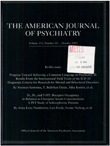Premigratory risk factors in Vietnamese Amerasians
Abstract
OBJECTIVE: The study's goal was to determine the ability of risk factors determined before migration to predict future levels of anxiety and depression in a group of Vietnamese Amerasian immigrants. METHOD: In a cohort of 161 randomly selected Vietnamese Amerasian youth in Vietnam awaiting placement, risk factors for psychological distress were identified with Felsman's 35-item Personal Information Form and the Hopkins Symptom Checklist-25 (HSCL-25). Ninety-five members of the original cohort were subsequently reevaluated, again with the HSCL-25, at a Philippine refugee center during their 6-month stay there awaiting placement in the United States. RESULTS: A statistically significant relationship was found between greater numbers of risk factors identified in Vietnam and higher total symptom levels in the Philippines. The strongest relationship was between greater numbers of risk factors and higher levels of depression. The relationship between number of risk factors and levels of anxiety was not significant. CONCLUSIONS: This study demonstrates the ability of risk factors determined prior to departure in Vietnam to predict future levels of psychological distress in a group of Vietnamese Amerasian immigrants.
Access content
To read the fulltext, please use one of the options below to sign in or purchase access.- Personal login
- Institutional Login
- Sign in via OpenAthens
- Register for access
-
Please login/register if you wish to pair your device and check access availability.
Not a subscriber?
PsychiatryOnline subscription options offer access to the DSM-5 library, books, journals, CME, and patient resources. This all-in-one virtual library provides psychiatrists and mental health professionals with key resources for diagnosis, treatment, research, and professional development.
Need more help? PsychiatryOnline Customer Service may be reached by emailing [email protected] or by calling 800-368-5777 (in the U.S.) or 703-907-7322 (outside the U.S.).



